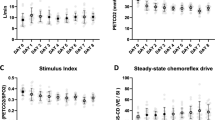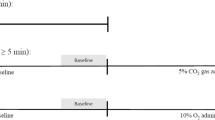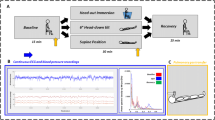Abstract
Acute hypoxia may alter autonomic cardiovascular reflexes during orthostasis. Heart rate variability (HRV), arterial blood pressure (MAP), and respiratory sinus arrhythmia (RSA) were recorded during supine (SUP) and passive head up tilt (HUT) in eight healthy humans, spontaneously breathing either room air or 10 % O2 in N2. In the time domain, heart rate increased and variability decreased with HUT in both trials, with no difference between trials. In the frequency domain, normalized low frequency HRV increased, and normalized high frequency HRV decreased with HUT in both trials, with no difference between trials. MAP was 74.9 (8.6) and 77.5 (11.7) mmHg when SUP in the room air and hypoxia trials, respectively. A significant increase in MAP occurred with HUT in the room air trial but not in the hypoxia trial. In both trials, end tidal CO2 decreased with HUT, with no difference between trials. In the room air trial, end tidal O2 increased with HUT, whereas during the hypoxia trial, end tidal O2 decreased with HUT. The distribution of heart beats relative to the phase of ventilation (%HBIN and %HBOUT) was similar in both trials: the %HBIN was 43.5 (3.3) % and %HBOUT was 56.5 (4.2) % breathing room air when SUP, and 45.5 (3.0) and 54.5 (3.2) when hypoxic and SUP. For both trials, this distribution did not change with HUT. As both HRV and RSA showed similar responses to HUT when spontaneously breathing either room air or 10 % O2 in N2, we suggest that autonomic cardiovascular reflexes are preserved during acute hypoxia.


Similar content being viewed by others
References
Bernardi L, Passino C, Spadacini G et al (1998) Cardiovascular autonomic modulation and activity of carotid baroreceptors at altitude. Clin Sci 95:565–573
Brown SJ, Howden R (2008) The effects of a respiratory acidosis on human heart rate variability. Adv Exp Med Biol 605:361–365
Brown SJ, Munel T, Brown JA (2007) Cardiac vagal control and respiratory sinus arrhythmia during hypercapnia in humans. J Physiol Sci 57:337–342
Brown SJ, Bryant M, Mündel T, Stannard SR (2009a) Human ventilatory efficiency and respiratory sinus arrhythmia during head-up tilt. J Physiol Pharm 59:771–780
Brown SJ, Mündel T, Barnes M, Brown JA (2009b) Tilt-induced changes in human heart rate variability with and without a respiratory acidosis. J Physiol Sci 59:31–36
Cooke WH, Hoag JB, Crossman AA, Kuusela TA, Tahvanainen KUO, Eckberg DL (1999) Human responses to upright tilt: a window on central autonomic integration. J Physiol 517:617–628
Cornolo J, Mollard P, Brugniaux JV et al (2004) Autonomic control of the cardiovascular system during acclimatization to high altitude: effects of sildenafil. J Appl Physiol 97:935–940
Eckberg DL, Barstow H, Scruby AE (1982) Modulation of human sinus node function by systemic hypoxia. J Appl Physiol 52:570–577
Grossman P, Taylor E (2007) Toward understanding respiratory sinus arrhythmia: relations to cardiac vagal tone, evolution and bio-behavioural functions. Biol Psych 74:263–285
Hainsworth R, Drinkhill MJ, Rivera-Chira M (2007) The autonomic nervous system at high altitude. Clin Auton Res 17:13–19
Hayano J, Yasuma F, Okada A, Mukai S, Fujinami T (1996) Respiratory sinus arrhythmia-phenomenon improving pulmonary gas exchange and circulatory efficiency. Circulation 94:842–847
Henriksen O, Rowell LB (1986) Lack of effect of moderate hypoxaemia on human postural reflexes to skeletal muscle. Acta Physiol Scand 127:171–175
Hirsch JA, Bishop B (1981) Respiratory sinus arrhythmia in humans: how breathing pattern modulates heart rate. Am J Physiol Heart Circ Physiol 241:H620–H629
Hughson RL, Yamamoto Y, McCullough RE et al (1994) Sympathetic and parasympathetic indicators of heart rate control at altitude studied by spectral analysis. J Appl Physiol 77:2537–2542
Iwasaki K, Ogawa Y, Aoki K et al (2006) Cardiovascular regulation response to hypoxia during stepwise decreases from 21 to 15% inhaled oxygen. Aviat Space Environ Med 77:1015–1019
Kamiya A, Hayano J, Kawada T et al (2005) Low-frequency oscillation of sympathetic nerve activity decreases during development of tilt-induced syncope preceding sympathetic withdrawal and bradycardia. Am J Physiol Heart Circ Physiol 289:H1758–H1769
Kochiadakis GE, Kanoupakis EM, Igoumenidis NE, Marketou ME, Solomou MC, Vardas PE (1998) Spectral analysis of heart rate variability during tilt-table testing in patients with vasovagal syncope. Int J Cardiol 64:185–194
Lemaitre F, Buchheit M, Joulia F, Fontanari P, Tourny-Chollet C (2008) Static apnea effect on heart rate and its variability in elite breath-hold divers. Aviat Space Environ Med 79:99–104
Marshall JM (1994) Peripheral chemoreceptors and cardiovascular regulation. Physiol Rev 74:543–594
Mazzeo RS, Child A, Butterfield GE et al (1998) Catecholamine response during 12 days of high-altitude exposure (4,300 m) in women. J Appl Physiol 84:1151–1157
Novak V, Novak P, Spies JM, Low PA (1998) Autoregulation of cerebral blood flow in orthostatic hypotension. Stroke 29:104–111
Perini R, Milesi S, Biancardi L, Veicsteinas A (1996) Effects of high altitude acclimatization on heart rate variability in resting humans. Eur J Appl Physiol Occup Physiol 73:521–528
Piccirillo G, Fimognari F, Viola E, Marigliano V (1995) Age-adjusted normal confidence intervals for heart rate variability in healthy subjects during head-up tilt. Int J Cardiol 50:117–124
Ponchia A, Noventa D, Bertaglia M et al (1994) Cardiovascular neural regulation during and after prolonged high altitude exposure. Eur Heart J 15:1463–1469
Prabhakar NR, Peng Y, Jacono F, Kumar G, Dick T (2005) Cardiovascular alterations by chronic intermittent hypoxia: importance of carotid body chemoreceptors. Clin Exp Pharm Physiol 32:447–449
Rickards CA, Newman DG (2002) The effect of low-level normobaric hypoxia on orthostatic responses. Aviat Space Environ Med 73:460–465
Rosner MJ, Coley IB (1986) Cerebral perfusion pressure, intracranial pressure, and head elevation. J Neurosurg 65:636–641
Saito S, Tanobe K, Yamada M, Nishihara F (2005) Relationship between arterial oxygen saturation and heart rate variability at high altitudes. Am J Emerg Med 23:8–12
Sevre K, Bendz B, Hankø E et al (2001) Reduced autonomic activity during stepwise exposure to high altitude. Acta Physiol Scand 173:409–417
Somers VK, Mark AL, Abboud FM (1991) Interaction of baroreceptor and chemoreceptor reflex control of sympathetic nerve activity in normal humans. J Clin Invest 87:1953–1957
Suzuki K, Asahina M, Suzuki A, Hattori T (2008) Cerebral oxygenation monitoring for detecting critical cerebral hypoperfusion in patients with multiple system atrophy during head-up tilt test. Inter Med 47:1681–1687
Thomas KN, Galvin SD, Williams MJA, Willie CK, Ainslie PN (2010) Identical pattern of cerebral hypoperfusion during different types of syncope. J Hum Hypertension 24:458–466
Toska K, Walloe L (2002) Dynamic time course of hemodynamic responses after passive head-up tilt and tilt back to supine position. J Appl Physiol 92:1671–1676
Tzeng YC, Larsen PD, Galletly DC (2007) Effects of hypercapnia and hypoxemia on respiratory sinus arrhythmia in conscious humans during spontaneous respiration. Am J Physiol Heart Circ Physiol 292:H2397–H2407
Yasuma F, Hayano J (2004) Respiratory sinus arrhythmia—why does the heart beat synchronize with respiratory rhythm? Chest 125:683–690
Author information
Authors and Affiliations
Corresponding author
Additional information
Communicated by Massimo Pagani.
Rights and permissions
About this article
Cite this article
Brown, S.J., Raman, A., Barnes, M.J. et al. Autonomic cardiovascular response to acute hypoxia and passive head-up tilting in humans. Eur J Appl Physiol 113, 1731–1736 (2013). https://doi.org/10.1007/s00421-013-2601-3
Received:
Accepted:
Published:
Issue Date:
DOI: https://doi.org/10.1007/s00421-013-2601-3




